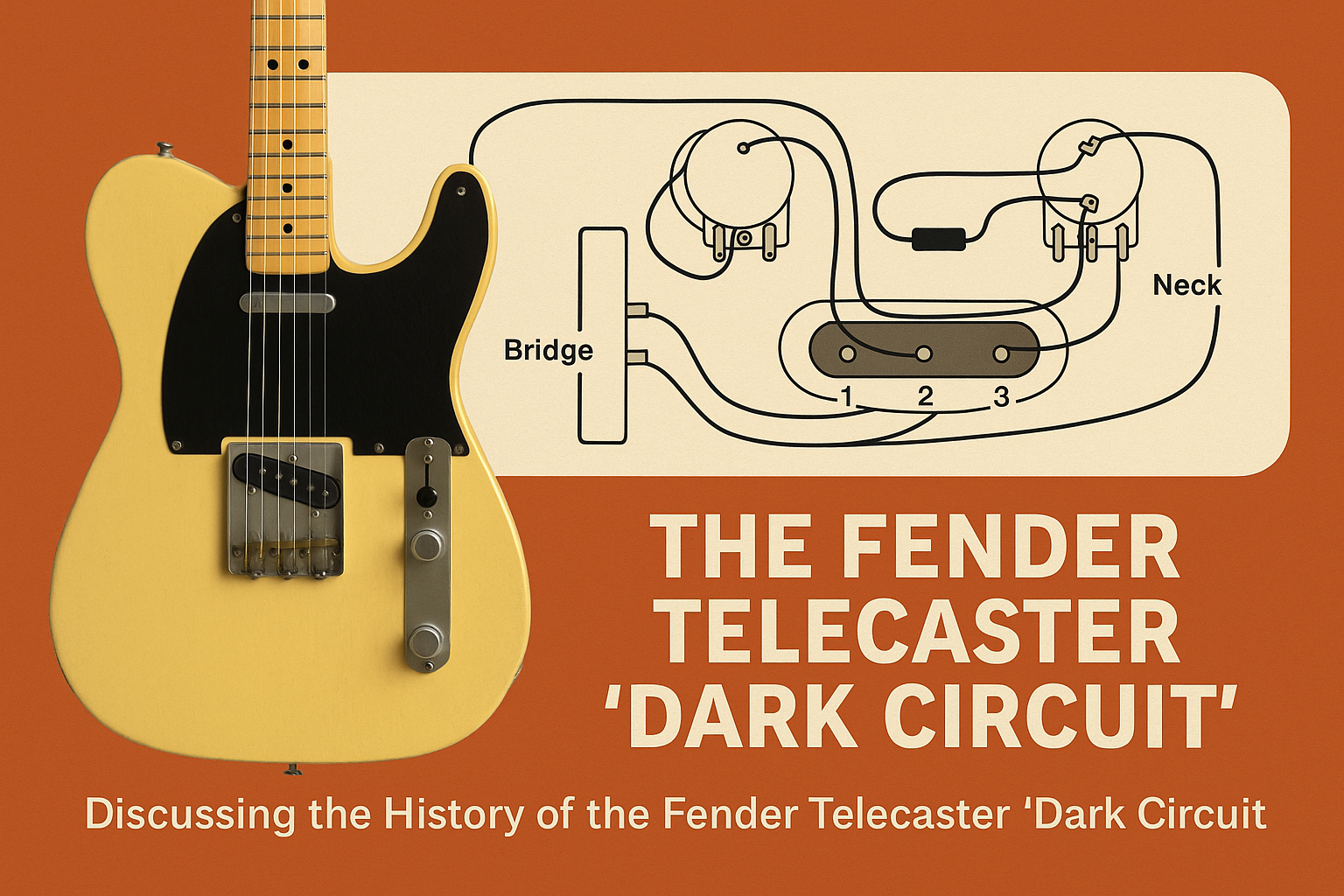When discussing the key developments in electric guitar electronics, one particular wiring scheme stands out for its historical importance and its tonal uniqueness: the so‑called “dark circuit” used early on in the Telecaster’s life. Here’s a look into its background, purpose, and how it evolved into the more familiar modern Tele wiring.
1. Historical context
The Telecaster (initially the Broadcaster/Nocaster) was introduced by Fender in the early 1950s. Around that era (roughly mid‑1952 through the mid‑1960s) Fender experimented with a wiring design that came to be known as the “dark circuit”. According to the article “Factory Telecaster Wirings, Pt. 1”:
“This circuit is often referred to as the ‘dark circuit’ … used from mid 1952 up to late 1967.”
The term “dark” stems from its effect: the neck pickup, in one of the switch positions, would deliver a bass‑heavier, rolled‑off treble sound — in contrast to the bright “twangy” character one associates with a Telecaster bridge pickup.
2. What the Dark Circuit did (functionality & design)
The dark circuit is distinct for a few technical features:
-
In a typical Tele wiring today, each position on the 3‑way switch selects bridge, both, or neck (depending on model/era) with master volume & tone knobs functioning on all positions. But in the early dark‑circuit wiring, the neck position was set up differently. As one write‑up explains:
“The ‘Dark Circuit’ took the standard three‑blade switch, but took positions 2 and 3 to control the neck pickup — leaving only position 1 to select the bridge pickup.”
-
It used two capacitors in the tone/treble‑cut network (rather than the single cap used later). In fact, the article notes:
“…original dark circuit … features … two Cornell Dubilier (CD) 0.05 µF/150 V paper‑waxed caps…”
-
In the “dark” position (neck pickup alone with treble roll‑off), the tone knob was often disabled (i.e., the preset cap network determined the sound), or the tone control was bypassed/locked.
Intention of use: The dark circuit seems to have been intended to provide a darker, warmer neck‑pickup sound — perhaps more bassy — to contrast with the sharper bridge pickup. Some accounts suggest Fender might have aimed to approximate a bass‑like tone (or at least reduce treble emphasis) in the neck position. For example, a listing for a “Dark Circuit 1953‑65” wiring kit says: “This circuit … was meant to imitate an electric bass in Pos. 1.”
Thus the dark circuit gave three distinct voices:
-
Bridge pickup (bright)
-
Neck pickup with heavy treble roll‑off (dark)
-
Possibly a middle position selecting neck in normal mode (depending on exact version)
It provided the player with a radical tonal shift by merely using the switch — from bright “twang” to darker “neck‑bass” flavour.
3. Evolution & transition to modern wiring
Over time, Fender modified the wiring schemes of the Telecaster. Key changes:
-
As noted, Fender’s wiring article says that the dark‑circuit scheme persisted roughly until late 1967.
-
According to the Andertons blog:
“Additionally, early ’50s models featured the so‑called ‘dark circuit’, which rolled off high end on the neck pickup to simulate a bassier tone. This was eventually replaced by a more traditional tone circuit later in the decade.”
-
The “traditional” / standard Telecaster wiring that became commonplace:
-
Switch Position 1: Bridge pickup alone (tone & volume active)
-
Position 2: Bridge + Neck in parallel (tone & volume active)
-
Position 3: Neck pickup alone (tone & volume active)
(Depending on model/era, some variants differ).
This gives a middle “both pickups” option, and tone knob functioning in all positions, offering more tonal flexibility.
-
-
The dark circuit’s two‑cap/tone‑bypass approach was simplified to a one‑cap, full‑tone‑control arrangement; this reduces part‑count and cost, and makes the guitar more flexible for general use.
4. Why the change?
Several practical reasons likely drove the evolution:
-
Flexibility: Guitarists wanted the tone control to work in all switch positions and the option of both pickups. The dark circuit was more specialised (one switch position locked into a heavily treble‑cut neck pickup sound).
-
Cost/complexity reduction: Using fewer parts (one capacitor vs two) lowers manufacturing cost and service complexity.
-
Standardisation: As guitars evolved and the user base broadened, a more standard circuit made sense for mass production.
-
Market demand: Perhaps the darker‑toned neck pickup was less in demand than the bright/versatile sounds, so Fender standardised to what players more commonly used.
5. Modern interest & revival
The dark circuit has become something of a “vintage wiring” flavour, sought by enthusiasts. A few points:
-
Many aftermarket kits exist to retrofit a Telecaster with dark‑circuit wiring (two caps, special switch behaviour). For example, the “Telecaster Dark Circuit 1953‑65 prewired kit” listing describes exactly replicating the old scheme.
-
On forums, users of reissues note that some ’60s‑era reissue Telecasters came with dark‑circuit wiring.
-
However, most modern factory Telecasters use the standard wiring as described above; the dark‑circuit is more of a niche/vintage feature.
6. Summary: Why it matters
The dark circuit is an important chapter in the Telecaster story, because:
-
It reflects how Fender experimented with tone and wiring early on — not just pickups and body materials.
-
It gives insight into how “what a guitar could sound like” changed over time — from more specialised tones to broader versatility.
-
For those interested in vintage tone or modifications, understanding the dark‑circuit wiring opens up tonal possibilities outside the norm.
Wiring Comparison: Dark Circuit vs Modern Tele
|
Feature |
Dark Circuit (1950s‑mid‑60s) |
Modern Standard Tele Wiring |
|---|---|---|
|
Number of capacitors in tone network |
Two capacitors (e.g., 0.05 µF paper‑wax) |
Usually one cap (e.g., 0.022 µF or 0.047 µF) |
|
Neck pickup switch position behaviour |
Neck only, treble heavily rolled off, tone control often bypassed |
Neck only, tone control active, full range of signal |
|
Middle position |
Often also neck pickup in “normal” mode (varies) |
Bridge + Neck in parallel, tone control active |
|
Manufacturing cost / complexity |
Higher: extra parts + special wiring |
Lower: simpler wiring, fewer parts |
|
Tonal flavour |
Very dark, bass‑heavy neck position, limited variety |
More versatile, any position tone control usable, both pickups possible |
Final Thoughts
The dark circuit may not be the wiring everyone wants today — many players prefer the brighter neck sound, the neck + bridge combo position, and tone control flexibility. But for history buffs, tone seekers or vintage‑style modifiers, the dark circuit offers a unique window into the early Telecaster’s soundscape and Fender’s design thinking at the time.









